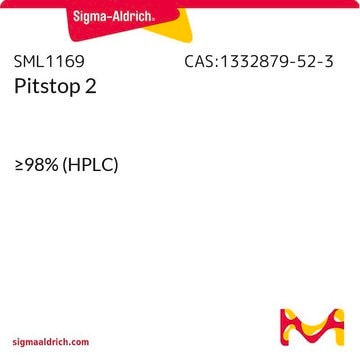SAE0088
Filipin complex ready made solution
from Streptomyces filipinensis, 5mg/ml in DMSO based solution
Sinonimo/i:
Filipin solution
Scegli un formato
Scegli un formato
About This Item
Prodotti consigliati
Saggio
≥90% (HPLC)
Stato
ready-to-use solution
Condizioni di stoccaggio
protect from light
Condizioni di spedizione
dry ice
Temperatura di conservazione
−20°C
Categorie correlate
Descrizione generale
Applicazioni
Azioni biochim/fisiol
Altre note
Filipin complex is used in various concentrations depending on the specific protocol used. Dilute 5mg/ml stock solution with appropriate buffer according to the used protocol.
Filipin complex interaction with cholesterol alters the absorption and fluorescence spectra, for visualization with a fluorescence microscope use excitation at 340-380 nm and emission at 385-470 nm (Filipin fluorescent staining photo-bleaches very rapidly, thus the sample should be analyzed immediately).
Codice della classe di stoccaggio
10 - Combustible liquids
Classe di pericolosità dell'acqua (WGK)
WGK 2
Punto d’infiammabilità (°F)
188.6 °F - closed cup
Punto d’infiammabilità (°C)
87 °C - closed cup
Scegli una delle versioni più recenti:
Certificati d'analisi (COA)
Non trovi la versione di tuo interesse?
Se hai bisogno di una versione specifica, puoi cercare il certificato tramite il numero di lotto.
Possiedi già questo prodotto?
I documenti relativi ai prodotti acquistati recentemente sono disponibili nell’Archivio dei documenti.
I clienti hanno visto anche
Filtri attivi
Il team dei nostri ricercatori vanta grande esperienza in tutte le aree della ricerca quali Life Science, scienza dei materiali, sintesi chimica, cromatografia, discipline analitiche, ecc..
Contatta l'Assistenza Tecnica.















